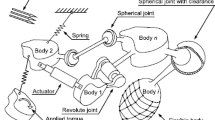Abstract
A computational method for the dynamic analysis of a constrained mechanical system is presented in this paper. The partial velocity matrix, which is the null space of the Jacobian of the constraint equations, is used as the key ingredient for the derivation of reduced equations of motion. The acceleration constraint equations are solved simultaneously with the equations of motion. Thus, the total number of equations to be integrated is equivalent to that of the pseudo generalized coordinates, which denote all the variables employed to describe the configuration of the system of concern. Two well-known conventional methods are briefly introduced and compared with the present method. Three numerical examples are solved to demonstrate the solution accuracy, the computational efficiency, and the numerical stability of the present method.
Similar content being viewed by others
References
Amirouche, F. M. L., 1992.Computational Methods in Multibody Dynamics, Prentice-Hall.
Baumgarte, J., 1972, “Stabilization Techniques of Constraints and Integrals of Motion in Dynamical Systems,”Computer Methods in Applied Mechanics and Engineering, Vol. 1, pp. 1–16.
Brenan, K. E., Campbell, S. L., and Petzold, L. R., 1996,Numerical Solution of Initial-Value Problems in Differential-Algebraic Equations, SIAM.
Chang, C. O. and Nikravesh, P. E., 1985, “An Adaptive Constraint Violation Stabilization Method for Dynamic Analysis of Mechanical Systems,”J. Mechanisms, Transmissions, and Automation in Design, Vol. 107, pp. 488–492.
Haug, E. J. and Yen, J., 1992, “Implicit Numerical Integration of Constrained Equations of Motion via Generalized Coordinate Partitioning,”J. Mechanical Design, Vol. 114, pp. 296–304.
Haug, E. J., 1989,Computer-Aided Kinematics and Dynamics of Mechanical Systems, ALLYN AND BACON.
Huston, R. L. and Passerello, C. E., 1979, “On Multi-rigid Body System Dynamics,”Computers & Structures, Vol. 10, pp. 439–446.
Huston, R. L. and Passerello, C. E., 1980, “Multibody Structural Dynamics including Translation between the Bodies,”Computers & Structures, Vol. 12, pp. 713–720.
Huston, R. L., Passerello, C. E., and Harlow, M. W., 1978, “Dynamics of Multirigid-Body Systems,”J. Applied Mechanics, Vol. 45, pp. 889–894.
Kamman, J. W. and Huston, R. L., 1984, “Dynamics of Constrained Multibody Systems,”J. Applied Mechanics, Vol. 51, pp. 899–903.
Kane, T. R. and Levinson, D. A., 1985,DYNAMICS: Theory and Application, Mcgraw-Hill.
Lee, D. C., Bae, D. S., Han, C. S., Seo, M. S., and Kim, J. Y., 1994a, “A Study on the Dynamic Analysis of Multibody System by the Relative Joint Coordinate Method,”Transactions of the KSME, Vol. 18, No. 7, pp. 1974–1984.
Lee, S. H., Bae, D. S., and Han, C. S., 1994b, “A Dynamic Analysis of Constrained Multibody Systems,”Transactions of the KSME, Vol. 18, No. 9, pp. 2239–2348.
Mani, N. K. and Haug, E. J., 1984, “Use of Singular Value Decomposition for Analysis and Optimization of Mechanical System Dynamics,”Technical Report 84-13, University of Iowa, Iowa City.
Park, J. H., Yoo, H. H., Hwnag, Y., and Bae, D. S., 1997, “Dynamic Analysis of Constrained Multibody Systems Using Kane’s Method,”Transactions of the KSME, Vol. 21, No. 12, pp. 2156–2164.
Park, T. W. and Haug, E. J., 1986, “Hybrid Numerical Integration Method for Machine Dynamic Simulation,”J. Mechanisms, Transmissions, and Automation in Design, Vol. 108, pp. 211–216.
Wehage, R. A. and Haug, E. J., 1982, “Generaized Coordinates Partitioning for Dimension Reduction in Analysis of Constrained Dynamic Systems,”J. Mechanical Design, Vol. 104, pp. 247–255.
Author information
Authors and Affiliations
Rights and permissions
About this article
Cite this article
Park, J.H., Yoo, H.H. & Hwang, Y. Computational method for dynamic analysis of constrained mechanical systems using partial velocity matrix transformation. KSME International Journal 14, 159–167 (2000). https://doi.org/10.1007/BF03184782
Received:
Revised:
Issue Date:
DOI: https://doi.org/10.1007/BF03184782




